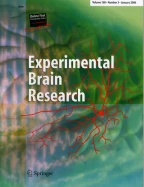Abstract
Perceptual direction detection thresholds for yaw rotation about an earth-vertical axis were measured at seven frequencies (0.05, 0.1, 0.2, 0.5, 1, 2, and 5 Hz) in seven subjects in the dark. Motion stimuli consisted of single cycles of sinusoidal acceleration and were generated by a motion platform. An adaptive two-alternative categorical forced-choice procedure was used. The subjects had to indicate by button presses whether they perceived yaw rotation to the left or to the right. Thresholds were measured using a 3-down, 1-up staircase paradigm. Mean yaw rotation velocity thresholds were 2.8 deg s−1 for 0.05 Hz, 2.5 deg s−1 for 0.1 Hz, 1.7 deg s−1 for 0.2 Hz, 0.7 deg s−1 for 0.5 Hz, 0.6 deg s−1 for 1 Hz, 0.4 deg s−1 for 2 Hz, and 0.6 deg s−1 for 5 Hz. The results show that motion thresholds increase at 0.2 Hz and below and plateau at 0.5 Hz and above. Increasing velocity thresholds at lower frequencies qualitatively mimic the high-pass characteristics of the semicircular canals, since the increase at 0.2 Hz and below would be consistent with decreased gain/sensitivity observed in the VOR at lower frequencies. In fact, the measured dynamics are consistent with a high pass filter having a threshold plateau of 0.71 deg s-1 and a cut-off frequency of 0.23 Hz, which corresponds to a time constant of approximately 0.70 s. These findings provide no evidence for an influence of velocity storage on perceptual yaw rotation thresholds.
Similar content being viewed by others
Notes
We use the term threshold as often defined by psychophysicists using signal detection theory, which is the level at which a signal becomes detectable relative to noise—where the noise includes noise inherent to the sensory system and may also include noise applied intentionally or incidentally via the stimuli.
A possible right side horizontal canal paresis was detected in one subject, and a slight VOR asymmetry in the other.
References
Benson AJ, Hutt EC, Brown SF (1989) Thresholds for the perception of whole body angular movement about a vertical axis. Aviat Space Environ Med 60:205–213
Clark B (1967) Thresholds for the perception of angular acceleration in man. Aerosp Med 38:443–450
Fernandez C, Goldberg J (1971) Physiology of peripheral neurons innervating semicircular canals of the squirrel monkey. II. Response to sinusoidal stimulation and dynamics of peripheral vestibular system. J Neurophysiol 34:661–675
Guedry F (1974) Psychophysics of vestibular sensation. In: Kornhuber (eds) Handbook of sensory physiology, vol VI. Springer, New York, pp 1–154
Ifediba MA, Rajguru SM, Hullar TE, Rabbitt RD (2007) The role of 3-canal biomechanics in angular motion transduction by the human vestibular labyrinth. Ann Biomed Eng 35:1247–1263
Leek MR (2001) Adaptive procedures in psychophysical research. Percept Psychophys 63:1279–1292
Merfeld DM, Park S, Gianna-Poulin C, Black FO, Wood S (2005a) Vestibular perception and action employ qualitatively different mechanisms. I. Frequency response of vor and perceptual responses during translation and tilt. J Neurophysiol 94:186–198
Merfeld DM, Park S, Gianna-Poulin C, Black FO, Wood S (2005b) Vestibular perception and action employ qualitatively different mechanisms. II. VOR and perceptual responses during combined tilt&translation. J Neurophysiol 94:199–205
Merfeld DM, Haburcakova C, Gong W, Lewis RF (2007) Chronic vestibulo-ocular reflexes evoked by a vestibular prosthesis. IEEE Trans Biomed Eng 54:1005–1015
Okada T, Grunfeld E, Shallo-Hoffmann J, Bronstein AM (1999) Vestibular perception of angular velocity in normal subjects and in patients with congenital nystagmus. Brain 122:1293–1303
Raphan T, Matsuo V, Cohen B (1977) A velocity storage mechanism responsible for optokinetic nystagmus (OKN), optokinetic after-nystagmus (OKAN) and vestibular nystagmus. In: Baker R, Berthoz A (eds) Control of gaze by brain stem neurons, developments in neuroscience, vol 1. Elsevier/North Holland Biomedical Press, pp 37–47
Robinson DA (1977) Linear addition of optokinetic and vestibular signals in the vestibular nucleus. Exp Brain Res 30:447–450
Treutwein B (1995) Adaptive psychophysical procedures. Vision Res 35:2503–2522
Wichmann FA, Hill NJ (2001) The psychometric function: I. Fitting, sampling, and goodness of fit. Percept Psychophys 63:1293–1313
Young LR, Oman CM (1969) Model for vestibular adaptation to horizontal rotation. Aerosp Med 40:1076–1080
Acknowledgments
We would like to thank the subjects for volunteering to participate, Robert S. Grimes for programming, Koeun Lim for assistance with data collection, and Mikail Massov for technical and mechanical support. This research was supported by the NIH/NIDCD grant DC04158 and the Swiss National Science Foundation PDFM1-114406.
Author information
Authors and Affiliations
Corresponding author
Rights and permissions
About this article
Cite this article
Grabherr, L., Nicoucar, K., Mast, F.W. et al. Vestibular thresholds for yaw rotation about an earth-vertical axis as a function of frequency. Exp Brain Res 186, 677–681 (2008). https://doi.org/10.1007/s00221-008-1350-8
Received:
Accepted:
Published:
Issue Date:
DOI: https://doi.org/10.1007/s00221-008-1350-8
